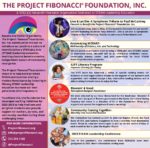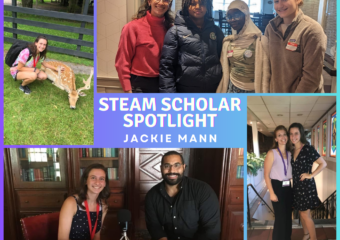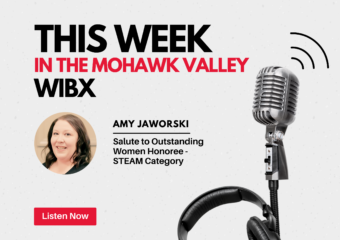The Daily Sentinel takes a closer look at area business in HORIZONS 2022.
ROME – The Project Fibonacci Foundation, a non-profit charitable organization registered in New York, has plans to bring a fully operational STEM plus arts (STEAM) center to downtown Rome by early 2023.
The facility is envisioned to be a collaborative center focused on programs designed to grow the local youth workforce in STEM (science, technology, engineering and mathematics). Aptly named the Multiversity of Science, Art, and Technology ― MOSART — the center will be part interactive exhibition center featuring artificial intelligence (AI) inspired art including traditional art works, part local venue for special community activities and guest speaker events, and part metro-hub for local STEAM leadership education programs.
According to Foundation Chairman Dr. Andrew Drozd, MOSART will be a community asset operated by the foundation.
The foundation’s board is raising funds for the project and seeks community support. Through public grant programs, tax-deductible private donations, and corporate donations the foundation anticipates raising $1 million this calendar year. The funds would cover facility acquisition, renovations, first-year operating expenses and job creation.
The foundation will offer a limited, multi-tiered first-founders club for organizations, families, individuals, and other stakeholders who wish to make a major, tax-deductible donation towards the project on a first-come, first-served basis. The foundation will dedicate office rooms, building wings, and founders’ bricks in the name of donors, family members or organizations to establish a durable community legacy.
Included will be an array of permanent exhibits that pay tribute in name and spirit to the leaders of industry, technology and manufacturing who built the Mohawk Valley focusing on aspects of science, technology, arts and history. It will showcase the influencers who contributed to our economy, history and cultural enrichment.
“This is a chance for community members and stakeholders to step up and positively influence our future and build on the shoulders of its citizen youth for generations to come,” said Drozd. “If you combine the cosmological ‘big bang’ and the idea of infinite multiverses, with university education and diversity of ideas all within the context of multidisciplinary learning, you get multiversity, ― an entirely new value proposition, ― a futuristic museum concept on steroids.”
Drozd said MOSART will be a popular destination for schools and visiting organizations.
“Downtown Rome, and its Downtown Revitalization Initiative renaissance, is a logical choice for its physical presence with its proximity to a premier research laboratory and emerging art scene,” he said.
The branding also captures the spirit of the foundation’s mission and vision, Drozd said.
“MOSART will neither be only a museum or only a learning-activities center, but both and more, and it will deliver on the goals of the Upstate Revitalization Initiative (URI) strategy,” he added.
The URI strategy includes expanding STEM industries and cultivating the STEM workforce through innovation hub and entrepreneurial network growth.
MOSART is envisioned to be an active hub for art- and science-themed exhibits, events and activities consistent with the foundation’s mission, to introduce youth to a culture of interdisciplinary, interactive STEAM learning, teaching them to become creative, independent leaders of community resurgence.
The foundation’s vision is Enriched STEAM Communities Driving a Modern Renaissance. The Classical Renaissance of the 15th and 16th centuries ushered a rebirth in major scientific and artistic achievements that stimulated societal and economic growth in Europe paving the way for the Age of Enlightenment, Industrial Revolution and a wealth of new economies globally.
“We want to recreate the impact the Classical Renaissance had and that continues today but reinvent it around entrepreneurism, youth and an agile STEM workforce. It is about creating the next Albert Einstein, Steve Jobs or a fresh-faced local innovator who will do great things,” said Drozd. “A dedicated MOSART center establishes permanent roots and deepens our commitment to the local community in support of job growth.”
Drozd said he anticipates 4-6 new jobs being created initially. He also anticipates hosting outside groups with common interests in promoting STEAM leadership education for STEM workforce development.
Drozd said he believes the Mohawk Valley community benefits from an energetic, forward thinking youth culture centered on science, art and technology looking ahead to consider what future generations will inherit.
“Rather than an image of a retirement village, we must expand our youth workforce and shore up the local youth talent pool by guiding and developing career opportunities,” Drozd said.
Several testimonials received from teachers, parents and STEAM scholars themselves over the past five years attest to the major impact the program has had in influencing STEM career choices.
“But more work is needed to connect students to area job opportunities to keep them local,” Drozd added.
MOSART will highlight the area’s strengths in science and technology, the expanding Arts District, its rich history and cultural diversity and especially its people, businesses and industries as a way of capturing youth.
Drozd said he has pondered the importance of the project asking, “What if we could capture lightning in a bottle by spotlighting our area’s contributions in science, art and technology all in one place and present it in a compelling way?”
He said, “Consider the Mohawk Valley’s rich legacy in engineering, technology and manufacturing and the movers and shakers who made it happen.”
On the manufacturing front, Rome gained a reputation as the Copper City for once producing an estimated 10 percent of all copper products in the U.S. led by the Revere Copper Company. Rome Strip Steel, founded by the Hinman family, brought the cold-rolled steel industry that served auto makers and other customers globally and is now Worthington Industries.
Today, manufacturing is a core component of our community: Indium Corporation and its global vision in material sciences.
“We believe that materials science changes the world,” said Drozd. “Wolfspeed is driving the industry transition from silicon to silicon carbide at their Marcy facility. Manufacturing is our past, present and future.”
On scientists, engineers and entrepreneurs, Benjamin Wright was chief engineer of the Erie Canal project assisted by John Jervis, also an engineer. There was Jesse Williams who implemented a technology for cheese making, John Dove who was instrumental in the development of CD-ROM technology, and Dr. Frank Maxson Potter who developed an early type of X-ray technology and in the early 1900s, patented a phone technology that was a precursor to the modern cell phone.
Entrepreneurs like the Sears family brought the Sears Oil Company to Rome. Today, the Innovare Innovation Advancement Center at Griffiss Technology Park is building a magnetic ecosystem in which the world’s leading scientific and entrepreneurial talent tackle the country’s greatest challenges to national security and economic competitiveness. The Northeast UAS Airspace Integration Research (NUAIR) Alliance, one of a select number of unmanned air system test sites designated by the Federal Aviation Administration (FAA), operates at Griffiss Park as does the Information Directorate of the Air Force Research Laboratory.
In a tribute to the community’s past, present and future, the center will host local industry and business exhibitions, and conduct the foundation’s ESTEAMED Speakers Series, a popular aspect of the annual STEAM conference that started in 2015. Celebrity keynote speakers have included “M*A*S*H” television star Alan Alda, astronauts Alan Bean and Chris Hadfield, physicist and futurist Dr. Michio Kaku, “Shark Tank’s” Damon John, Hidden Figures author Margot Lee Shetterly, actor Stephen Lang of “Avatar” movie fame, neuroscientist Dr. David Eagleman of the PBS series “The Brain: The Story of You,” to name a few.
MOSART will also host the annual STEAM conference activities. The conference, delayed by the recent pandemic, brings more than100 regional and statewide students to Rome for one week to tackle important socio-techno-economic issues. The 2023 conference theme is sustainability and climate change adaptation. The tentative 2024 theme will focus on medicine and technology.
Drozd also suggested hosting joint-community special events at MOSART in cooperation with the Capitol Theatre, Rome Art and Community Center, Munson Williams-Proctor Arts Institute in Utica, Rome Historical Society, Fort Stanwix National Monument, Griffiss Institute, SUNY Polytechnic, Mohawk Valley Community College and other organizations.
The long-term collaboration with these and other community partners will ensure their success and sustainability in the community, Drozd said. The foundation is exploring a joint-collaboration event called Light Falls Space and an Obsession of Einstein, a live theatrical journey about Einstein’s groundbreaking discoveries presented by famed physicist Dr. Brian Greene.
Activity rooms or maker spaces would be used to host the foundation’s annual array of STEAM programs from sculpture spaces to joint-research apprenticeships, mini-drone camps, and the annual STEAM conference workshops.
Exhibits will span the history of the Mohawk Valley’s technological achievements from the Erie Canal project to the present. SciArt exhibits and projects would include resonance art, sound sculpting, bioinspired engineering, the science of art conservation, and the art and math of the cosmos.
Displays could include pendulum clocks, walking on water exhibits, art through chemistry, and more. AI-inspired art is another offering where the public would be able to interact with technoart exhibits powered by AI for a unique discovery-learning experience.
AI-projection art projects, virtual zoos and simulated space flights, and other examples using AI-holographics may be added over time. The art and science exhibits would be rotated periodically and incorporate live demonstrations. The foundation has already reached out to the Smithsonian Museum in Washington, D.C. and World Science Festival in New York City to explore partnerships for traveling science-art exhibits in the future, including collaborations on AI-projection art projects in western New York, the Southern Tier, and in Santa Cruz, California.
Asked why art plays such an important role, Drozd said, “Ours is not a STEM program. It is no surprise though that art can positively affect STEM outcomes, but we have examined that impact more deeply. Simply, our prime directive is to ramp up growth in the local STEM workforce and the arts play a critical role because the talents of artistic thinkers can be used to solve complex STEM problems ― artistic perspectives drive creativity, diversity of solutions, and lead to technological innovation. We just need to smartly cast a wider net.”
Drozd and his team have conducted in-depth research on human and machine learning frameworks noting that World War II codebreakers in the Pacific Theatre were largely musicians and mathematicians.
“Most educators understand the arts, when used effectively, can improve STEM outcomes, but more importantly, it is about the ‘what’ and ‘how’ and we have a proven formula to change the game, which answers the ‘why,’” he said.
Drozd is working on the STEM-Prism project, which uses AI as a delivery platform for STEM education and hopes to monetize it as a product to generate sustainable revenues for MOSART.
The foundation’s multidisciplinary focus further underscores the importance of life-career core values including ethics that enable youth to explore, learn and excel across a spectrum of STEAM career opportunities.
According to foundation volunteer and Fourth Ward Councilor Ramona Smith, the vision is built around youth and STEAM programs for community revitalization ― culturally, economically, scientifically and artistically reinforcing the community’s identity, encouraging community pride by connecting its members and fostering a sense of belonging, and enhancing the quality of life for all.
“MOSART expands the notion of STEAM as a blend of science, technology, arts, history, and culture reflecting our area’s rich, eclectic heritage, which is often underappreciated,” said Drozd.
Smith added, “Such enrichment helps our youth develop the necessary critical and creative-thinking skills to meet the job demands of the 21st century and fosters an entrepreneurial mindset.”
The foundation’s motivation is to attract people to live, work and play in Rome and the Mohawk Valley and create a lasting, positive legacy of cultural enrichment and economic sustainability.
“The broader vision of STEAM is to Stimulate Thought-leadership, Experience, and Advancement of the Mind through entrepreneurial, community, and economic well-being,” he added.
Drozd said he believes MOSART will be a jewel in the crown of the foundation’s broader agenda and will benefit the area’s collective future.
“In addition to an exhibition floor, offices, activity and maker spaces, we would look to lease out space to other organizations for us to generate steady recurring revenues, Drozd said.
The foundation is in discussions with multiple property owners to determine the best step forward for MOSART. Drozd maintains confidentiality on the matter until the final discovery and negotiations process is completed.
The board, which includes business-side Executive Director Bob Bojanek and educator-side Executive Co-director Tamalin Martin, both of Rome, along with a group of celebrity/industry advisors and a representative from NASA’s Johnson Space Center, is committed to realizing the project to its fruition.
ANDRO Computational Solutions, LLC has announced it will contribute up to $50,000 to kick-start a corporate matching program on behalf of MOSART.
For more information on fundraising options and to participate in an opportunity to create a new legacy for future growth and prosperity of Rome and the greater Mohawk Valley, contact Drozd at adrozd@projectfibonacci.org or call 315-335-1238.
Tax-deductible donations can be sent to the Project Fibonacci Foundation, Inc., P.O. Box 424, Rome, N.Y. 13442-0424.
Read the whole story here




